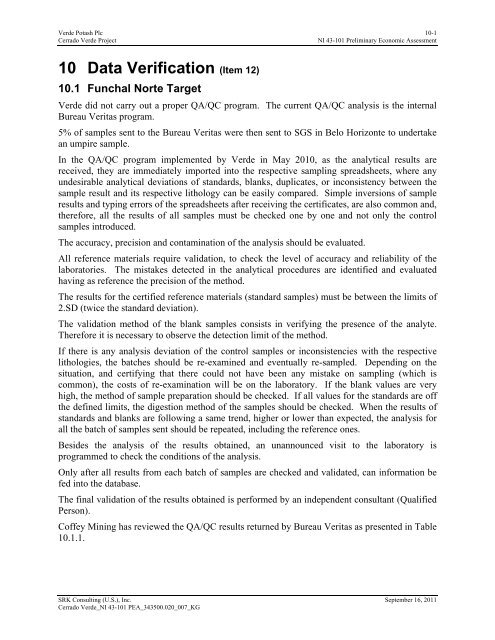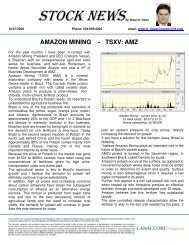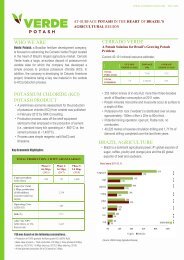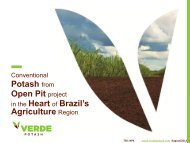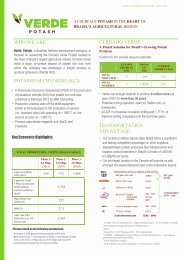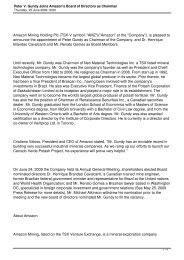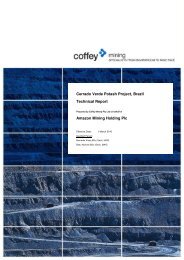NI 43-101 Preliminary Economic Assessment - Verde Potash
NI 43-101 Preliminary Economic Assessment - Verde Potash
NI 43-101 Preliminary Economic Assessment - Verde Potash
You also want an ePaper? Increase the reach of your titles
YUMPU automatically turns print PDFs into web optimized ePapers that Google loves.
<strong>Verde</strong> <strong>Potash</strong> Plc 10-1<br />
Cerrado <strong>Verde</strong> Project<br />
<strong>NI</strong> <strong>43</strong>-<strong>101</strong> <strong>Preliminary</strong> <strong>Economic</strong> <strong>Assessment</strong><br />
10<br />
Data Verification (Item 12)<br />
10.1 Funchal Norte Target<br />
<strong>Verde</strong> did not carry out a proper QA/QC program. The current QA/QC analysis is the internal<br />
Bureau Veritas program.<br />
5% of samples sent to the Bureau Veritas were then sent to SGS in Belo Horizonte to undertake<br />
an umpire sample.<br />
In the QA/QC program implemented by <strong>Verde</strong> in May 2010, as the analytical results are<br />
received, they are immediately imported into the respective sampling spreadsheets, where any<br />
undesirable analytical deviations of standards, blanks, duplicates, or inconsistency between the<br />
sample result and its respective lithology can be easily compared. Simple inversions of sample<br />
results and typing errors of the spreadsheets after receiving the certificates, are also common and,<br />
therefore, all the results of all samples must be checked one by one and not only the control<br />
samples introduced.<br />
The accuracy, precision and contamination of the analysis should be evaluated.<br />
All reference materials require validation, to check the level of accuracy and reliability of the<br />
laboratories. The mistakes detected in the analytical procedures are identified and evaluated<br />
having as reference the precision of the method.<br />
The results for the certified reference materials (standard samples) must be between the limits of<br />
2.SD (twice the standard deviation).<br />
The validation method of the blank samples consists in verifying the presence of the analyte.<br />
Therefore it is necessary to observe the detection limit of the method.<br />
If there is any analysis deviation of the control samples or inconsistencies with the respective<br />
lithologies, the batches should be re-examined and eventually re-sampled. Depending on the<br />
situation, and certifying that there could not have been any mistake on sampling (which is<br />
common), the costs of re-examination will be on the laboratory. If the blank values are very<br />
high, the method of sample preparation should be checked. If all values for the standards are off<br />
the defined limits, the digestion method of the samples should be checked. When the results of<br />
standards and blanks are following a same trend, higher or lower than expected, the analysis for<br />
all the batch of samples sent should be repeated, including the reference ones.<br />
Besides the analysis of the results obtained, an unannounced visit to the laboratory is<br />
programmed to check the conditions of the analysis.<br />
Only after all results from each batch of samples are checked and validated, can information be<br />
fed into the database.<br />
The final validation of the results obtained is performed by an independent consultant (Qualified<br />
Person).<br />
Coffey Mining has reviewed the QA/QC results returned by Bureau Veritas as presented in Table<br />
10.1.1.<br />
SRK Consulting (U.S.), Inc. September 16, 2011<br />
Cerrado <strong>Verde</strong>_<strong>NI</strong> <strong>43</strong>-<strong>101</strong> PEA_3<strong>43</strong>500.020_007_KG


